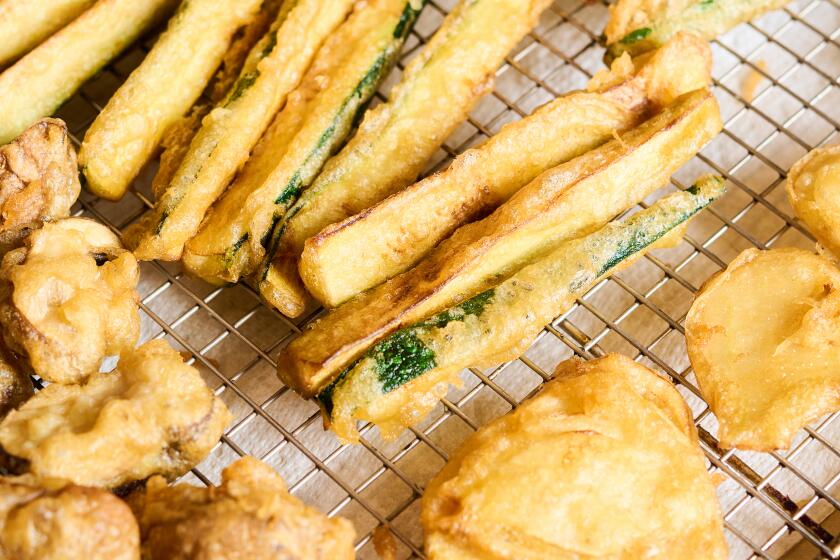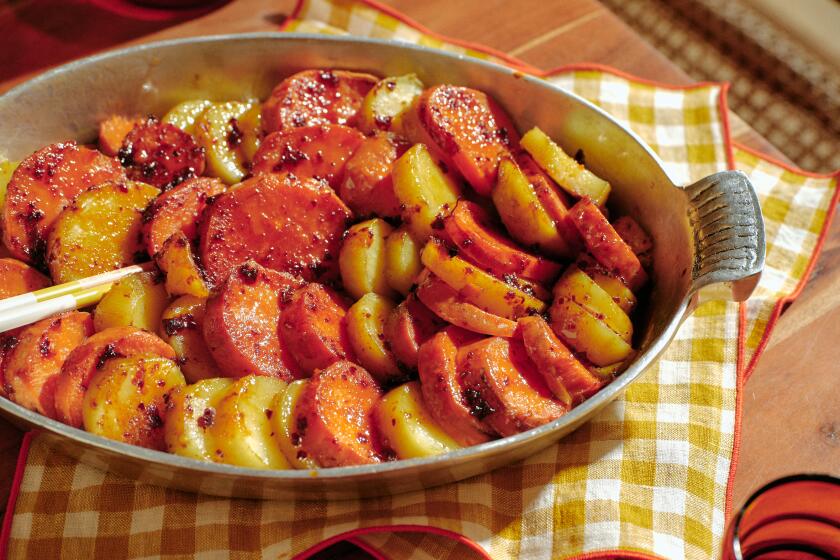Zucchini crumble
- Share via
All I was hoping for at lunch in the Nice-Cote d’Azur airport was something slightly better than the chicken or “beef” Air France would undoubtedly be shoveling out. What I got was a good table with a view of the sea (and runway), an even better rose and the best idea for late summer cooking.
It landed in the form of a clafouti made not with cherries but with cherry tomatoes. The restaurant, Le Badiane, had converted the dessert classic into a first course, with julienned bits of saucisson and sun-dried tomatoes in a creamy custard scented with rosemary and topped with small, juice-oozing cherry tomatoes. Even slightly overcooked, it was sensational.
And it made me think of how many other sweet ideas could be turned savory at a time of year when even the most sublime vegetables are starting to taste a little too familiar no matter what clever cooking techniques you put them through. Rather than a cherry cobbler, why not a spicy one made with corn? Instead of a peach crisp, why not a cheesy one with zucchini?
Summer, of course, always brings out the inner Careme in American cooks. For pastry-chef wannabes, corn pudding is an old standard, tomato tarts are modern staples. But the French are particularly inspirational with their gateaux. Olive cakes turn up all over Provence and Languedoc-Roussillon, particularly at aperitif time. Walk into any party where Champagne is being poured, and you will usually be offered a wedge.
These cakes often include lardons but can also be made with vegetables, particularly zucchini. Cheese, olive oil, milk and eggs give the loaf-shaped cakes a spongy richness. Small squares can be hors d’oeuvres; a thick slice is almost lunch.
A French friend gave me her aunt’s recipe for a basic olive cake, loaded with half a pound of sliced green olives and a quarter of a pound each of lardons and grated Gruyere. She also makes it with artichoke hearts instead of olives, rounding out the flavor with lemon juice, pine nuts and parsley.
Another of her variations includes fennel, dill seeds and a little pastis.
Other standard French recipes substitute wine or vermouth for the milk, or diced ham for the lardons. Always, the quality of the olives is key. Lucques olives are traditional in Languedoc, Nyons in Provence, but other French green olives or even the Greek ones work well. Just don’t use those pimento-stuffed ones from the supermarket; they’re fine in a martini but taste mostly like green salt in a savory cake.
The clafouti came without a recipe, but it was surprisingly easy to replicate by just omitting the sugar and reducing the flour in the usual batter poured over cherries or other fruit. Eggs, milk, melted butter, a little flour, chopped fresh rosemary and salt and pepper can all be whizzed with a blender to make a smooth liquid to cover the strips of saucisson and sun-dried tomatoes in small gratin dishes. The batter puffs slightly as it bakes around the cherry tomatoes, which should be the smallest you can find.
You could serve this as a first course, as a light lunch or especially for brunch, with a crisp white wine or a super-summery rose. It’s best hot but quite respectable at room temperature.
Like all savory transformations of dessert techniques, the clafouti has a hide-in-plain-sight aspect: It’s so obvious it’s surprising. Beyond the wow factor, though, the whole concept is a way of making more of the best of what late summer brings.
For other vegetable-dessert hybrids, the topping can transform a side dish. You could just cream corn with poblanos and squash and ladle the whole combination alongside grilled fish, but if you add a flaky biscuit dough lightened with cream, you bake up something much more substantial, not to mention dramatic.
Stewed zucchini and tomatoes seasoned with basil and garlic are another summer predictability -- until they are covered in a crisp topping with Parmigiano-Reggiano and lots of butter with a little flour.
A cynic might say vegetable crisps and cobblers are just rarefied casseroles, but these are two cases where nomenclature upgrades them to business class. Which, as it happens, is just what eating that clafouti as insurance against dismal coach fodder mysteriously did for me.
Heat the oven to 375 degrees. In a large mixing bowl, combine the zucchini, tomatoes, garlic and basil and mix well. Season with 1 1/4 teaspoons salt and one-fourth teaspoon pepper and mix in the chile flakes. Adjust seasoning to taste. Spread into a 9-inch square baking dish.
Wipe the bowl dry and add the flour, pine nuts and cheese. Using your fingertips, rub in the butter until the mixture resembles coarse crumbs and starts to clump. Crumble evenly over the zucchini mixture.
Bake 1 hour, until the topping is crisp and the vegetables are stewed.
Get our Cooking newsletter.
Your roundup of inspiring recipes and kitchen tricks.
You may occasionally receive promotional content from the Los Angeles Times.















